Lithium Battery Voltage
Keheng is a leading lithium batetry company, with extensive experience and deep industry background, dedicated to developing high-performance lithium battery products and providing comprehensive solutions for variety applications. We offer high volume and customized production services for providing one-stop energy storage systems. Our products include 12V/ 24V/ 36V/ 48V/ 60V/ High Voltage lithium battery, using LFP/ Sodium/ NMC as the raw material of batteries.
As a lithium battery factory, we offer different voltage battery solutions, including but not limited to:
12V lithium Battery
24V lithium Battery
48V lithium Battery
60V lithium Battery
HV lithium Battery
Our lithium battery products utilize the latest different lithium cells including cylindrical battery cells: 18650/21700/26650/32600 etc. and prismatic batetry cells.
We can provide customized lithium-ion batteries services like unconventional size and shape,
Special batteries used in low temperature.
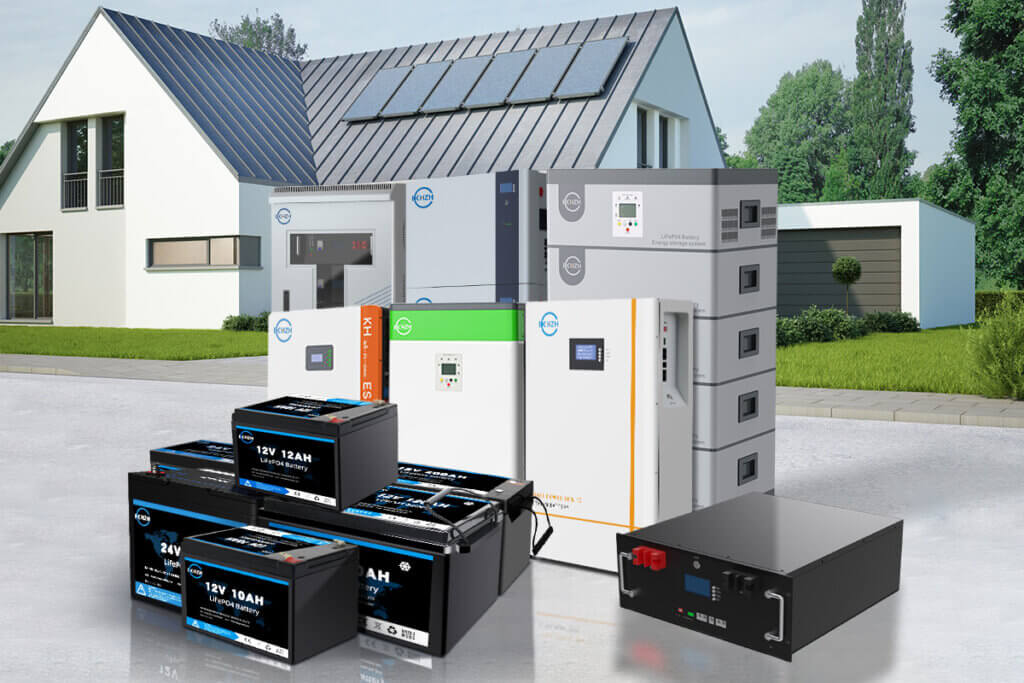
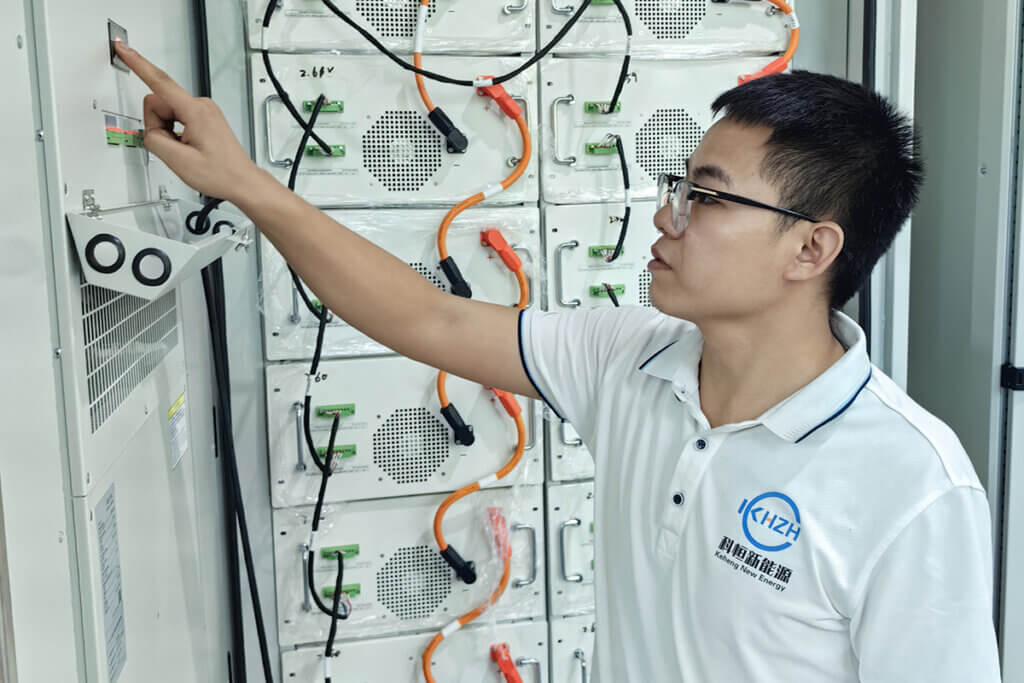
Quality and Reliability
Keheng has its own QC team to ensure that all products are inspected prior to shipment to minimize failure rates and ensure superior reliability when they reach the customer. We also have a strict quality control process at the production stage, where both raw materials and semi-finished products are sampled, inspected and tested. Finished products are certified to meet international standards.
Contact Us
To learn more about the lithium battery knowledge, please leave us message. We look forward to share with you more industry news!
lifepo4 battery voltage chart
Lifepo4 Battery Voltage Overview
Lithium iron phosphate (Lifepo4) batteries are favored by electric bicycles, EVs, forklifts, marine, AGVs, sweepers, etc. based on high energy density, long cycle life and high safety.Lifepo4 batteries are preferred for high-performance applications because of their stable voltage, stable power output and wide operating temperature range.This article focuses on the voltage diagram of Lifepo4 and the Lifepo4 VS.NMC.
What is LiFePO4 voltage chart?
Lithium Iron Phosphate (Lifepo4) battery voltage chart, usually Lifepo4 has a specific discharge curve, from 100%-0% the voltage between them also varies according to the capacity.
|
State Of Charge(SOC)
|
1 PCS
|
12V
|
24V
|
36V
|
48V
|
|---|---|---|---|---|---|
|
100% Charging
|
3.65V
|
14.6V
|
29.2V
|
43.8V
|
58.4V
|
|
100% Rest
|
3.4V
|
13.6V
|
27.2V
|
40.8V
|
58.4V
|
|
90%
|
3.35V
|
13.4V
|
26.8V
|
40.2
|
53.6
|
|
80%
|
3.32V
|
13.28V
|
26.56V
|
39.84V
|
53.12V
|
|
70%
|
3.3V
|
13.2V
|
26.4V
|
39.6V
|
52.8V
|
|
60%
|
3.27V
|
13.08V
|
26.16V
|
39.24V
|
52.32V
|
|
50%
|
3.26V
|
13.04V
|
26.08V
|
39.12V
|
52.16
|
|
40%
|
3.25V
|
13V
|
26V
|
39V
|
52V
|
|
30%
|
3.22V
|
12.88V
|
25.76V
|
38.64V
|
51.52V
|
|
20%
|
3.2V
|
12.8V
|
25.6V
|
38.4
|
51.2V
|
|
10%
|
3V
|
12V
|
24V
|
36V
|
48V
|
|
0%
|
2.5V
|
10V
|
20V
|
30V
|
40V
|
The LiFePO4 Cell has a discharge cut-off voltage of 2.5V, a float voltage of 3.65V and a nominal voltage of 3.2V.
3.2V Lifepo4 Cell Charge/Discharge Functions
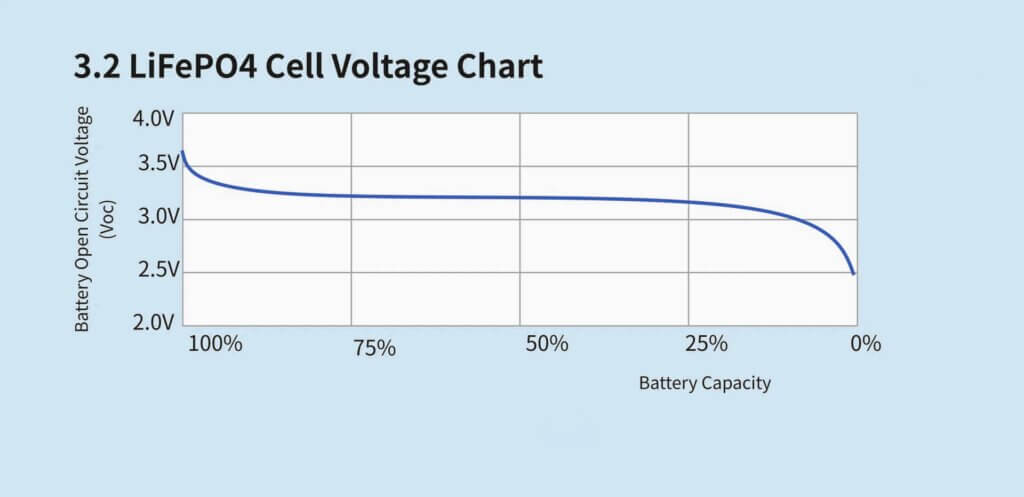
12V Lifepo4 Pack Charge/Discharge Functions
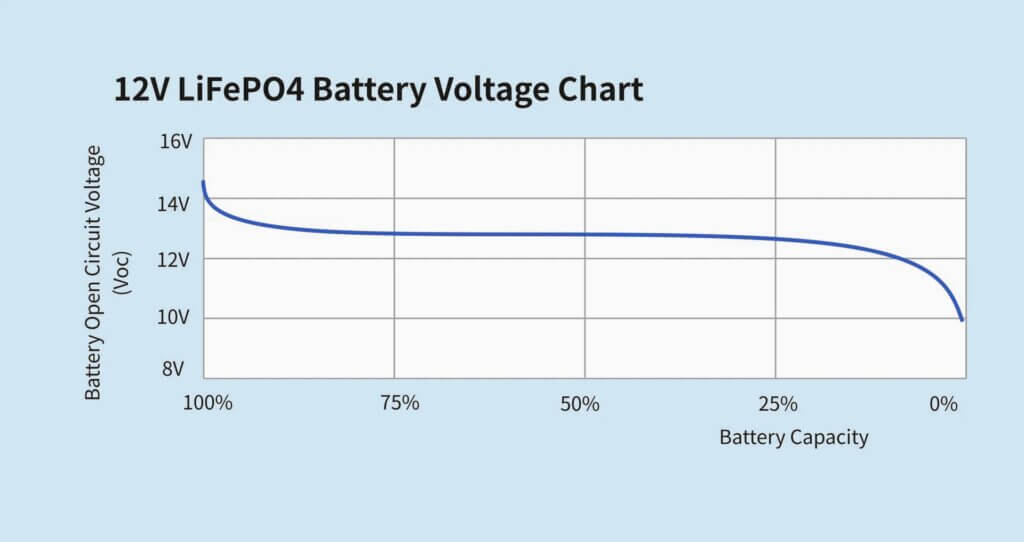
LiFePO4 Cell has a discharge cut-off voltage of 10V, a float voltage of 14.6V and a nominal voltage of 12.8V.
24V Lifepo4 Pack Charge-Discharge Function Diagram
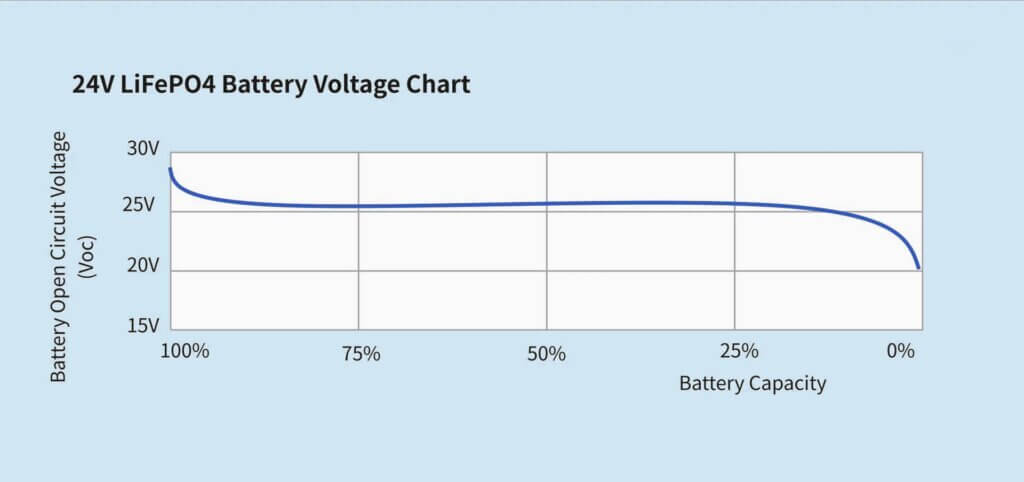
LiFePO4 Cell with a discharge cut-off voltage of 20V, float voltage of 29.2V and nominal voltage of 25.6V.
36V Lifepo4 Pack Charge/Discharge Functions

LiFePO4 Cell has a discharge cut-off voltage of 30V, a float voltage of 43.8V and a nominal voltage of 38.4V.
48V Lifepo4 Pack Charge/Discharge Functions
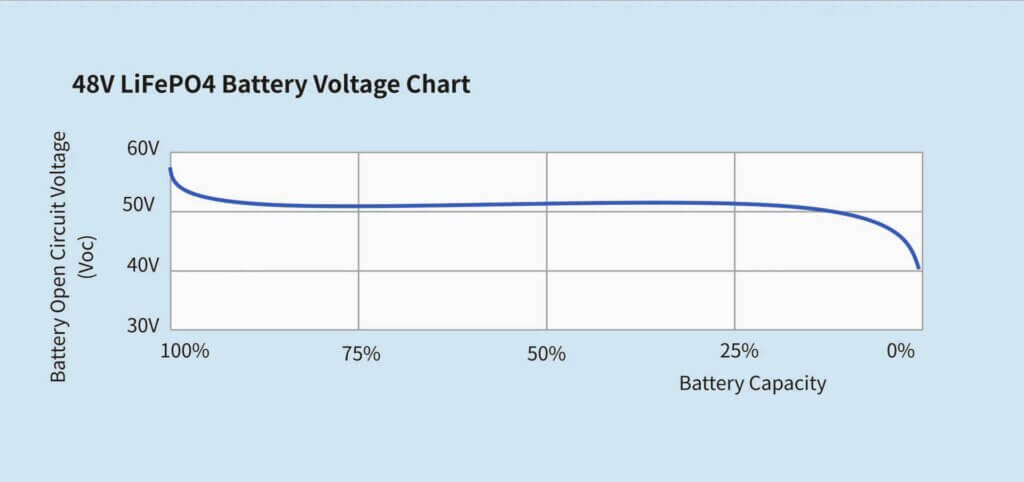
LiFePO4 Cell has a discharge cut-off voltage of 40V, a float voltage of 58.4V and a nominal voltage of 51.2V.
What is the State of Charge (SOC) and the voltage relationship of the SOC?
State of Charge ( SoC ) is the charge level of a battery relative to its capacity.SoC is usually expressed as a percentage (0% = empty; 100% = full). Another form of the same measurement is the Depth of Discharge (DoD), calculated as 100 – SoC (100% = empty; 0% = full). SoC is often used when discussing the current state of a battery in use, while DoD is most often used when discussing the life of a battery after repeated use. from Wikipedia
As the SCO (State of Charge) widens at 0% and then does the exact opposite when it reaches 100%, the BMS steps in to protect the battery from over-discharging when the battery is fully discharged, however, the charging process slows down to protect the battery as it approaches 100%.
The table below shows the voltage range of the Lifepo4 Cell.
|
SOC (State Of Charge)
|
Voltage (V)
|
|---|---|
|
100%
|
3.60-3.65V
|
|
90%
|
3.50-3.55V
|
|
80%
|
3.45-3.50
|
|
70%
|
3.40-3.45V
|
|
60%
|
3.35-3.40V
|
|
50%
|
3.30-3.35V
|
|
40%
|
3.25-3.30V
|
|
30%
|
3.20-3.25V
|
|
20%
|
3.10-3.20V
|
|
10%
|
2.90-3.00V
|
|
0%
|
2.00-2.50
|
Charge state curve
Voltage: The higher the nominal voltage of the battery, the more fully charged the battery proves to be, e.g. a Lifepo4 battery with a nominal voltage of 3.2V reaches a voltage of 3.65V then the battery has been greatly maximized.
Coulomb Meter: Measure the current flowing into and out of the battery and use Ampere Seconds (As) to measure the charging and discharging rate of the battery.
Specific Gravity: You will need a hydrometer to measure the SoC. it works by monitoring the density of the liquid based on buoyancy.

LiFePO4 Battery Charging Parameters
LiFePO4 battery charging parameters include different types of voltages, such as charging voltage, float voltage, maximum voltage/minimum voltage and nominal voltage. The following table shows the charging parameters for 3.2V, 12V, 24V, 36V and 48V.
|
Charging parameters
|
3.2V
|
12V
|
24V
|
36V
|
48V
|
|---|---|---|---|---|---|
|
Charging Voltage
|
3.5~3.65V
|
14.2~14.6V
|
28.4~29.2V
|
42.6~43.8V
|
56.8~58.4V
|
|
Float Voltage
|
3.65V
|
14.6V
|
29.2V
|
43.8V
|
58.4V
|
|
Maximum Voltage
|
2.5V
|
10V
|
20V
|
30V
|
40V
|
|
Minimum Voltage
|
3.65V
|
14.6V
|
29.2V
|
43.8V
|
58.4V
|
|
Nominal Voltage
|
3.2V
|
12.8V
|
25.6V
|
38.4V
|
51.2V
|
Lifepo4 Battery Discharge Diagram
Discharging is the process of removing power from a battery to charge an appliance. Battery discharge graphs usually represent the relationship between voltage and discharge time. The following graph shows the discharge curve of 12V LiFePO4 at different discharge multipliers.

Factors affecting battery SOC
Factors affecting the SOC of a battery can be categorized into temperature, materials, application, and maintenance.
Battery temperature: If the temperature of the battery is too high or too low, it will reduce the charging efficiency of the battery.
Battery material: different batteries are made of different materials, so the material will also affect the SOC.
Battery Application: Different application scenarios or uses will also affect the SOC.
Battery Maintenance: If incorrect battery maintenance is taken, then the battery life and SOC will also be affected.
What is the capacity range of Lithium Iron Phosphate batteries?
Lithium Iron Carbonate Batteries increase the capacity and voltage of the battery by Parallel Vs. Series Batteries, the series connection can increase the voltage, and the parallel connection increases the capacity. The more cells of Li-FePO4 battery are connected in parallel, the higher the battery capacity. Common battery capacity is 10Ah, 20Ah, 50Ah, 100Ah, 150Ah, 200Ah, etc.
Comparison of the parameters of lithium iron phosphate and lithium ternary batteries
|
|
NMC
|
LFP
|
|---|---|---|
|
Nominal Voltage
|
3.6V
|
3.2V
|
|
Charging Voltage
|
4.2V
|
3.65V
|
|
Minimum Voltage
|
2.5V
|
2.5V
|
|
Maximum Voltage
|
4.2V
|
3.65V
|
|
Battery Capacity (mAh/g)
|
~195
|
~145
|
|
Energy density (wh/kg)
|
~240
|
~170
|
|
Cycle Life
|
3000
|
5000
|
|
Thermal Stability Safety
|
150-200℃
|
300℃
|
Lithium iron phosphate battery visual energy structure and working principle
Structure
On the right is LiFePO4 as the positive electrode of the battery, which is connected to the positive electrode of the battery by an aluminum foil, in the middle is a polymer diaphragm, which separates the positive electrode from the negative electrode, but the lithium ion Li+ can pass through it while the electron e- can’t pass through it, and on the right is the negative electrode of the battery which is composed of carbon (graphite), which is connected to the negative electrode of the battery by a copper foil.

Lifepo4 battery working principle!
When a LiFePO4 battery is being charged, the lithium ion Li+ in the positive electrode migrates to the negative electrode through the polymer diaphragm; during discharge, the lithium ion Li+ in the negative electrode migrates to the positive electrode through the diaphragm. Lithium-ion batteries are named for the back and forth migration of lithium ions during charging and discharging.
How to check the capacity of lithium iron phosphate battery?
Make sure it is fully charged: Use a charger that is suitable for the battery’s match and fully charge the battery..
Use professional equipment: Test with a specialized battery tester (multimeter) that can provide accurate readings and tell you the actual capacity of the battery.
Perform a discharge test: Connect the battery to a constant load, which should be a safe value within the battery’s normal operating range. Record the discharge time to ensure that the battery is fully discharged (the battery reaches its minimum voltage) for the time required.
Calculate capacity: Calculate the battery capacity using the following formula: Capacity (Ah) = Discharge current (A) x Discharge time (hours)
For example, if the battery has been discharged for 5 hours under a 1 Amp load, the capacity is 5 Ah.
LiFePO4 Battery Cycle Life and Influencing Factors
Charge and Discharge
The battery will not go through excessive charging and discharging, make sure to link and unplug the charger in time, overcharging and over-discharging will affect the cycle life of the battery.

Depth of discharge
The higher the depth of discharge, the greater the impact on the life of the battery, so try not to deep discharge, you can scientifically extend the life of the carbonate paste battery.
Working environment
Ensure that the lithium battery will not be used in high or low-temperature environments, so as not to affect the internal battery activity, if the lithium battery is used in lower temperatures, then a heated lithium battery is your best choice.

